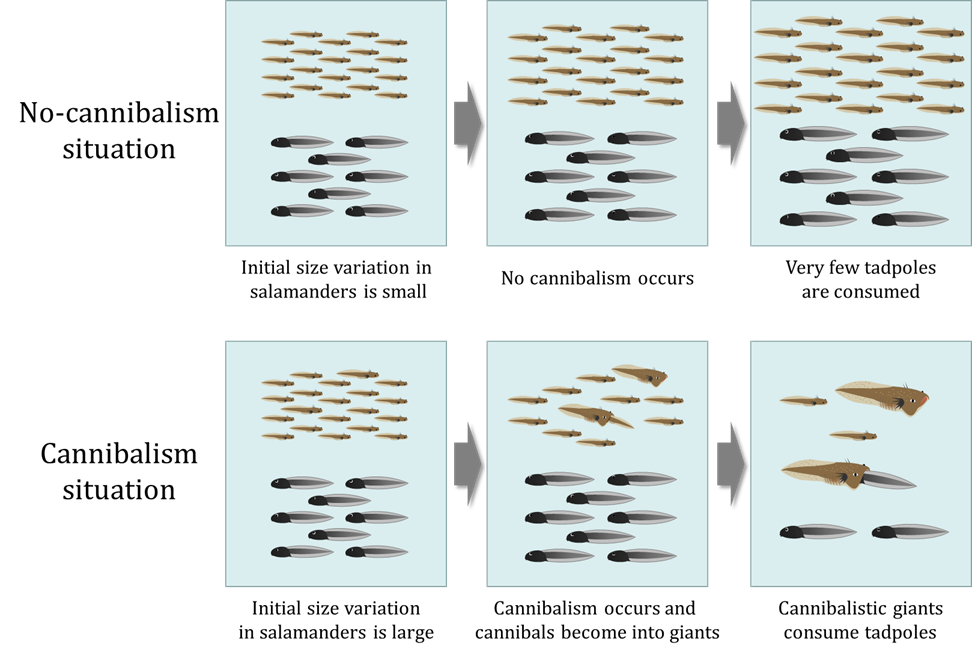Ecologists have not paid much attention to the fact that organisms grow during their ontogeny. Our group has therefore been exploring the ecological impacts of the growth of individuals.
Predator cannibalism can intensify the impacts of predators on their heterospecific prey
Past studies have consistently shown that predator cannibalism can weaken predator effects on heterospecific prey, both by reducing predator density and by lowering the feeding activity of the non-cannibalistic predators. However, we found that cannibalism among H. retardatus salamander hatchlings can lead to intensified predation pressure on R. pirica frog tadpoles (Takatsu & Kishida 2015) . Size dynamics on an ecological time scale is the key to solving the mystery of this counterintuitive impact of predator cannibalism on prey. Salamander hatchlings that become cannibals and consume conspecific hatchlings grow rapidly into giants. These giants can subsequently easily consume R. pirica tadpoles, a relatively large prey species. This negative impact of predator cannibalism on the tadpoles enabled by the rapid growth of the cannibals overwhelms the positive impacts due to the reduced predator density and the defensive behavior of the non-cannibalistic larvae. Because animals commonly broaden their diet as they grow, such negative impacts of predator cannibalism on heterospecific prey may be common in interactions between predator and prey species of similar size.
Reference
Takatsu K. & Kishida O. (2015) Predator cannibalism can intensify negative impacts on heterospecific prey. Ecology. In press.
How does hatching phenology affect the outcomes of predator–prey interactions?
An effective way of understanding predator–prey interactions in specific ecological scenarios is to consider the size dynamics of the predator–prey system. In many size-dependent predator–prey systems, hatching phenology strongly affects the outcomes of predator–prey interactions. For example, early-hatched predators encounter smaller prey, which they can easily consume. However, early hatching alone cannot explain all predator–prey interaction outcomes over the whole interaction period because size balance between predator and prey changes dynamically throughout the ontogenies of the two species.
We hypothesized that hatching phenology influences predator–prey interactions via a feedback mechanism between the predator–prey size balance and prey consumption by predators (Nosaka et al. 2015). We tested this hypothesis in a simple predator–prey model system consisting of H. retardatus larvae and R. pirica tadpoles. Usually, the frog tadpoles hatch up to five weeks earlier than the salamanders. In our experiment, we exposed frog tadpoles to a predatory salamander larva that had hatched 5, 12, 19, or 26 days after the frog tadpoles had hatched. We found that in the initial period the salamanders that hatched earlier succeeded in consuming more frog tadpoles than the ones that hatched later. Moreover, the early-hatched salamanders grew rapidly, so they were able to maintain their size superiority over the tadpoles in the subsequent period. Thus, they continued to exert strong predation pressure on the frog tadpoles. Furthermore, the frog tadpoles exposed to the early-hatched salamanders remained tadpoles longer and were larger at metamorphosis than the other frog tadpoles. These results support our hypothesis that a critical feedback mechanism exists between the predator–prey size balance and prey consumption by the predator and that this mechanism accounts for the strong impact of the hatching phenology of the predator on the short-term population dynamics and life history of the prey.
Reference
Nosaka M., Katayama N. & Kishida O. (2015) Feedback between size balance and consumption strongly affects the consequences of hatching phenology in size-dependent predator–prey interactions. Oikos. 124:225-234.


